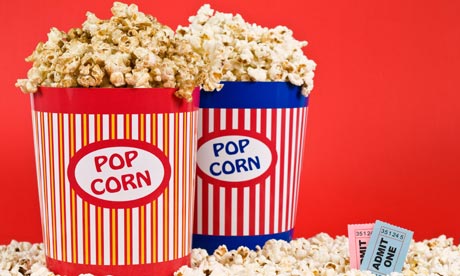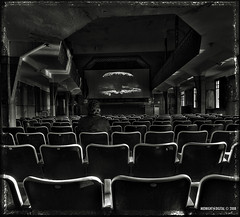I’ve written before about multiplex cinema chains ramping up the cost of going to a movie, discounted at slow times in various promotions but still nothing like the cheap experience it used to be in my teens. They justify the increase by saying movies (by which they mean big-budget action movies, as a rule) cost more to make and are more innovative – though I personally don’t think gimmicks like 3D are innovative or any advance. Quite the reverse – often they disguise the paucity of imagination in the quality of the things that matter: the story, the script and the acting. The more screens, the less real choice and the almost total absence of quality, some weeks.
It’s a shame, but that is not the main subject of this short blog. What really gets my goat is how the cinema chains get you as a captive audience then sell you refreshments at exorbitant sums. While costs of sweets, drinks, ice creams and other junk are all hideously over-priced, chief amongst the offenders is popcorn, which, following the American tradition, seems to have become de rigueur, and the subject of a Watchdog investigation (see here.) This is worth reprinting in full:
Remember the old days of cinema? Ornate venues, classic movies, matinee idols – and when cinema snacks didn’t cost a fortune. Rick Wakeman takes a look at the price of popcorn in our largest cinemas, and starts a little venture of his own…
We all know cinema popcorn is expensive, but take a deep breath and have a look at what the London branches of the three largest chains are charging. A small box of sweet popcorn from Vue is £4.70 (or £3.15 per 100g), from Odeon £3.95 (£5.27 per 100g) and from Cineworld it’s £4.00 – that’s a whopping £6.35 per 100g!
Of course, we don’t have to buy it, we’re just a captive audience. However, one chain, Cineworld, seem keen on eliminating any competition. Julie Chambers visited her local cinema with friends and their children’s bags were searched. On finding popcorn, cinema staff would not allow them to take in the popcorn. Julie thinks the cinema realises that if people bring their own food in to the cinema then they they won’t buy food there, and therefore the cinema won’t make as much profit.
But how much money ARE cinemas making from popcorn? You can buy a bag of popcorn from the supermarket for 91p per 100 grams, yet Cineworld sell theirs for £6.45 per 100 grams. If they sold that in the foyer that’s a 600% markup. Cinemas can buy in bulk, thus making it even cheaper to purchase, but can anyone buy in bulk?
We tried and found we could buy popcorn for 33 pence per 100 grams if the order was big enough, and we could also buy printed boxes for 10 pence. So making a 62 gram box like Cineworld’s would cost 21 pence for the popcorn – that’s 31 pence in total. Selling this at £4.00 as cinemas do, that’s makes for just under a 1200% markup! Very tasty.
However, film journalist Charles Gant told us that STILL doesn’t reflect what some cinema’s make. He says it’s likely that big chains can get their popcorn even cheaper, and consequently have higher profit margins. Gant also said to bear in mind that the portion of the ticket price kept by the cinema isn’t really enough to pay for the costs of the business, they need to make their money from concessions, which is why they’re so expensive.
So cinemas seem to charge these prices on the grounds that they’d make a loss otherwise. Seems a bit odd, given that cinema attendances hit one of their highest rates for 25 years last year; we bought 169 million tickets in 2010.
That’s a lot of people that need feeding, which gave Rick Wakeman an idea. He took to the streets with his own popcorn cart. Sadly, as he was working for the BBC, he couldn’t sell popcorn, but he did give away Rick’s Grumpy Popcorn to passersby in London. At 31p cost per box, if he shifted 100 a day, and sold them at the prices the big chains do, he’d make £2500 a week! Beats playing the piano for a living…
Cineworld statement to BBC Watchdog:
“Our first priority is to keep our ticket prices as low as possible. Food and drink are a fun, optional extra treat for our customers and overall cinema remains great value compared to other leisure activities. We offer a range of good value deals with drinks and popcorn so it is not realistic to compare the price per 100g as this isn’t how the majority of our popcorn is sold. The price of a product is affected by many more factors than the cost of the raw ingredient, such as rent and staff wages.
We do ask that customers don’t bring in their own food and drink, just as in any location where food and drink are sold. It is important that we search bags for security and piracy prevention, but in the course of this particular search in Milton Keynes we acknowledge that we could have handled the situation more sensitively and apologise that our usual high standards of customer service were not quite met.”
Odeon statement to BBC Watchdog:
As the UK’s largest cinema chain, ODEON is committed to providing guests with a choice of deals on a wide range of food and drink. This includes our Film Feast, a good value offer for the price conscious customer which contains a bag of popcorn, packet of sweets and a soft drinkfor £2.99.
ODEON does not have a policy against people taking their own food into screenings, other than when it can affect other guests’ enjoyment – for example odorous foods – and discretion is therefore left to the individual cinema managers.
A Vue spokesperson said:
Vue’s pricing of retail items is in line with other out-of-home entertainment venues. We also provide special offers on certain ticket deals including our Kids AM and Teen pricing tickets and Nectar points can also be redeemed against retail products.
Overall, Vue is proud to offer a comprehensive choice of competitively priced ticket options to ensure a visit to the cinema continues to provide great value for money for everyone. Ticket prices start from as little as £1.25 for our Kids AM shows and there are also discounts for everyone if they visit when it is quieter; Saver and Super Saver rates offer 10% and 25% off our peak rates. We are also part of Orange Wednesdays (241 tickets) and we redeem Nectar Points
Vue was the first cinema company to offer teen pricing, providing special low pricing for teens all year round and we also have Senior Club which also offers reduced rates and special screenings for those aged over 60. In addition to our fantastic Kids AM screenings, our family tickets mean adults pay child prices when accompanying 2/3 children in a group of 4 people.
Providing choice is key – we offer both 2D and 3D versions of the same film so consumers have the choice to pay the 3D premium or not, and all our other upgrades whether it be VIP seating or Over18 movies screenings and Vue Extreme screens are also optional.
Cinema remains one of the best value out-of-home experiences and we regularly consult our customer base and external research to ensure that this is maintained.
Other features about the price of popcorn have also appeared in the media (see here, here, here and here for example.) Does it make any difference? Not one jot! Certainly doesn’t seem to stop us going to the cinema, nor buying their overpriced merchandise. I have on occasions taken my kids to Cineworld Braintree, and when there is time to spare wandered over to the Freeport designer outlet village, where I can buy toffee popcorn and sweets for both my kids with change from £2 at the Cadburys outlet shop, plus a bottle of water each for £1.
In the event that Cineworld stopped us bringing in our snacks, searched bags or instigated any other heavy-handed measure, I would simply stop going there. Luckily, Orange saw this trend coming and made a wonderful send-up of the issue of security in movie houses (see here.) Think this satire says it all!
However, there is a blog here which justifies the price mechanism used in cinemas for determining the retail value of the products they sell. This is also worth repeating:
Why is popcorn at the cinema so expensive?
Posted onWhy is popcorn at the cinema so expensive? At my local cinema, you’d expect to pay about £3 ($6) for some popcorn or about £8 ($16) for a meal deal including maybe a hot dog and nachos. This is absolutely extortionate given you can get popcorn for a third of the price at the supermarket just across the road and for £8 you could get a decent sit-down meal at a good restaurant.
So is this a rip off for consumers? In this article, I discuss the issue of expensive popcorn, how it can be explained with price targeting and suggest that isn’t a rip off at all.
A cup of coffee…
Let us imagine a cup of coffee which costs £1 to produce.
There are 6 consumers who all value the cup of coffee differently. Person A is willing to pay £1 for a cup of coffee, going all the way up to Person F who would be willing to pay £3.50 for a cup of coffee.
The shop decides to charge £2 for a cup of coffee so for every cup of coffee sold the shop makes a profit of £1. As we can see in the table, Persons A and B would not buy the coffee because it costs more than what they would be willing to pay. 4 people would buy the coffee, giving the shop a total profit of £4.
Let’s increase the price…
Of course, the owner of the coffee shop wants to increase his profits. So he could increase the price of a cup of coffee: say to £2.50.
What’s happened? Well, Person C no longer wants to buy a cup of coffee as it would cost more than they were willing to pay. Persons D, E and F will continue to buy the cup of coffee. The coffee shop sells 3 cups of coffee and makes a total profit of £4.50. The downside is that Person C no longer has access to a cup of coffee.
We could try increasing the prices further with the aim of trying to increase profit. If the price of coffee rose to £3, the profit on each cup of coffee is £2. But only Persons E and F would buy it, giving a total profit of £4.
As we can see, the optimal price to charge is £2.50. This would give the coffee shop maximum profit without using price targeting.
What if we use price targeting?
My argument lies around “price targeting”. What exactly is price targeting? It means charging people exactly what they are willing to pay. Take the following scenario:
So what has happened here?
Well, every single person now has access to a cup of coffee at the price that they would be willing to pay. Not only that, but the shop has managed to increase it’s profit to £7.50: almost double what it could have made without price targeting.
Leakages
But there is a big problem with this plan which economists call “leakages”. How can the firm know exactly how much customers are willing to pay? They could ask the customers but everyone would say they were willing to pay the bare minimum figure: £1. Because who would pay more than they would have to for some coffee? So we end up with the following scenario where everybody ends up paying the bare minimum:
Everyone has access to a cup of coffee. But it costs £1 to make a cup of coffee and everybody pays £1: the shop owner makes no profit at all.
The problem with this form of price targeting is that people will find ways to abuse the system. Everybody will pay the bare minimum. This is why you won’t see it used this way in practice: when was the last time you sat down at a restaurant where you could pay however much or little as you wanted?
There are several ways that companies can implement price targeting without explicitly asking you how much you’d be willing to pay. I would like to argue that popcorn at the cinema is one example.
Popcorn as a form of price targeting
photo: Midnight-digital
At the start of this article, I said that popcorn was a form of price targeting. Why?
Everybody would love popcorn and a drink to go with a film. If you don’t believe me ask yourself the following question: if I was given a free popcorn and drink with my cinema ticket would I take it? For most people, the answer will be a resounding yes.
Let’s say it costs the cinema £5 to screen Indiana Jones. For £9 my local cinema could provide everyone with a film and a popcorn. For every ticket sold, they make a profit of £4. But instead they offer two options:
£7 – Film Only
£10 – Film and PopcornLet us imagine a customer who is willing to pay £8 to see Indiana Jones. In the original scenario without price targeting, everybody is charged £9. Since he is only willing to pay £8, he won’t go to the cinema: it’s too expensive. But if the cinema offered a £7 option, he will now decide to go. The cinema will make a £2 profit.
Let us imagine another customer willing to pay £12. He will go for the “film and popcorn” option at £10. It’s essentially exactly the same product: the popcorn only costs pennies to produce. But there is sufficient difference between the two options that the customer won’t “leak” into the £7 group.
Why aren’t you allowed to take your own food and drink into the cinema? Because that’d cause £10 customers to “leak” into the £7 group.
Conclusion
Popcorn is a form of price targeting: a way of charging people the amount they are willing to pay. I have shown that this not only leads to increased profits for the cinema chain, it also means the cinema is affordable to a lot more people. Of course popcorn doesn’t cost £3 to produce. But that expensive popcorn serves an important purpose in allowing price targeting to work. Ultimately, consumers benefit from great access to the cinema.
There’s nothing terribly revolutionary about this, I’d put it in a simpler way: in Economic theory, this is about the price elasticity of demand and the fact that there is no alternative within the cinema to give people a choice – there, the seller is a monopolist and free to exploit the audience – so they do.
That they act as a cartel in overpricing the products is hardly surprising – but it doesn’t cast them in a good light at all. It’s unnecessary and damages their reputation. Unlike Cineworld, I don’t view this as an add-on treat – fact is that people do like to much while they watch movies, to the extent that selling popcorn nearer cost price may even attract more people through the door ahead of the competing cinemas.













